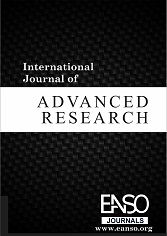Production of Chitosan from Crab Shells
Abstract
The amino polysaccharide of chitin polymer happens to be the most commonly known polymer. Chitosan as a derivative of chitin is obtained through demineralization and deacetylation. Owing to the special properties of chitin and chitosan for instance their bio-compatibility, bio-biodegradability, non-toxicity and also capability to form films, have resulted in their suitability in chemical and thermal conductivity applications. In the field of nanotechnology, chitosan-based materials are currently being widely applied. The purpose of this review is to synthesize and characterize chitosan obtained from the crab shells. The absorption band obtained from FTIR between 1220 cm−1 and 1020 cm−1 represented free amino group (−NH2). The 40.000 grams of powdered crab shells resulted in the formation of 23.000g of chitin after undergoing the process of demineralization to eliminate the minerals available in the crab shells. The removed minerals from the crab shells constituted 17.000 g (39.53%) of the total dry weight in the crab shell. The water binding capacity (WBC) was found to be 69 %.
Downloads
References
Abirami, S., Samrot, A. V., Sakthikavitha, M., Revathi, P., Varsini, A. M., Dhiva, S., Saigeetha, S., Shobana, N., & Prakash, P. (2021). Extraction of chitosan from crab shell and fungi and its antibacterial activity against urinary tract infection-causing pathogens. Journal of Pure and Applied Microbiology, 15, 968–975.
Azimi, N., Gandomkar, A., & Sharif, M. (2023). Relationship between production condition, microstructure and final properties of chitosan/graphene oxide–zinc oxide bionanocomposite. Polymer Bulletin, 80(6), 6455–6469. https://doi.org/10.1007/s00289-022-04277-0.
Benamer Oudih, S., Tahtat, D., Nacer Khodja, A., Mahlous, M., Hammache, Y., Guittoum, A., & Kebbouche Gana, S. (2023). Chitosan nanoparticles with controlled size and zeta potential. Polymer Engineering & Science, 63(3), 1011– 1021. https://doi.org/10.1002/pen.26261
El-Araby, A., Janati, W., Ullah, R., Ercisli, S., & Errachidi, F. (2024). Chitosan, chitosan derivatives, and chitosan- based nanocomposites: Eco-friendly materials for advanced applications (a review). Frontiers in Chemistry, 11, 1327426.
Erdoğmuş, S. F., Altıntaş, Ö. E., & Çeli̇K, S. (2023). Production of fungal chitosan and fabrication of fungal chitosan/polycaprolactone electrospun nanofibers for tissue engineering. Microscopy Research and Technique, 86(10), 1309–1321. https://doi.org/10.1002/jemt.24315
Ge, J., Li, M., Fan, J., Celia, C., Xie, Y., Chang, Q., & Deng, X. (2024). Synthesis, characterization, and antibacterial activity of chitosan-chelated silver nanoparticles. Journal of Biomaterials Science, Polymer Edition, 35(1), 45– 62. https://doi.org/10.1080/09205063.2023.2265629
Gîjiu, C. L., Isopescu, R., Dinculescu, D., Memecică, M., Apetroaei, M.-R., Anton, M., Schröder, V., & Rău, I. (2022). Crabs marine waste—A valuable source of chitosan: Tuning chitosan properties by chitin extraction optimization. Polymers, 14(21), 4492.
Hao, G., Hu, Y., Shi, L., Chen, J., Cui, A., Weng, W., & Osako, K. (2021). Physicochemical characteristics of chitosan from swimming crab (Portunus trituberculatus) shells prepared by subcritical water pretreatment. Scientific Reports, 11(1), 1646.
Iber, B. T., Kasan, N. A., Torsabo, D., & Omuwa, J. W. (2022). A review of various sources of chitin and chitosan in nature. Journal of Renewable Materials, 10(4), 1097.
Ismail, R., Fitriyana, D. F., Bayuseno, A. P., Pradiptya, P. Y., Muhamadin, R. C., Nugraha, F. W., Setiyawan, A., Bahatmaka, A., Firmansyah, H. N., & Anis, S. (2023). Investigating the effect of deacetylation temperature on the characterization of chitosan from crab shells as a candidate for organic nanofluids. Journal of Advanced Research in Fluid Mechanics and Thermal Sciences, 103(2), 55–67.
Javaid, M. A., Jabeen, S., Arshad, N., Zia, K. M., Hussain, M. T., Ullah, I., Ahmad, S., & Shoaib, M. (2023). Preparation of amylopectin and chitosan-based polyurethanes for sustained drug release studies. Sustainable Chemistry and Pharmacy, 33, 101086.
Jia, X., Ma, P., Wei, C.-I., & Wang, Q. (2024). Chitin and chitosan: Pioneering sustainable substrates for next-generation soilless vertical farming. Trends in Food Science & Technology, 104599.
Li, B., Wu, X., Bao, B., Guo, R., & Wu, W. (2021). Evaluation of α-chitosan from crab shell and β-chitosan from squid gladius based on biochemistry performance. Applied Sciences, 11(7), 3183.
Muñoz-Nuñez, C., Cuervo-Rodríguez, R., Echeverría, C., Fernández-García, M., & Muñoz-Bonilla, A. (2023). Synthesis and characterization of thiazolium chitosan derivative with enhanced antimicrobial properties and its use as component of chitosan-based films. Carbohydrate Polymers, 302, 120438.
Olafadehan, O. A., Amoo, K. O., Ajayi, T. O., & Bello, V. E. (2021). Extraction and characterization of chitin and chitosan from Callinectes amnicola and Penaeus notialis shell wastes. J Chem Eng Mater Sci, 12(1), 1–30.
Spósito, L., Fonseca, D., Carvalho, S. G., Sábio, R. M., Marena, G. D., Bauab, T. M., Meneguin, A. B., Parreira, P., Martins, M. C. L., & Chorilli, M. (2024). Engineering resveratrol-loaded chitosan nanoparticles for potential use against Helicobacter pylori infection. European Journal of Pharmaceutics and Biopharmaceutics, 199, 114280.
Suryani, S., Chaerunisaa, A., Joni, I. M., Ruslin, R., Aspadiah, V., Anton, A., Sartinah, A., & Ramadhan, L. O. A. (2024). The Chemical Modification to Improve Solubility of Chitosan and Its Derivatives Application, Preparation Method, Toxicity as a Nanoparticles. Nanotechnology, Science and Applications, Volume 17, 41–57. https://doi.org/10.2147/NSA.S450026
Wang, H., Zhang, H., Liu, L., Ma, K., Huang, J., & Zhang, J. (2023). Design and experimental study on the closed‐loop process of preparing chitosan from crab shells. Biotechnology and Applied Biochemistry, 70(3), 1421–1434. https://doi.org/10.1002/bab.2450
Copyright (c) 2024 Martin Ouma Osemba, Mary Muriuki-Hutchins, PhD, Samuel Karenga, PhD, Godfrey Keru, PhD

This work is licensed under a Creative Commons Attribution 4.0 International License.




























